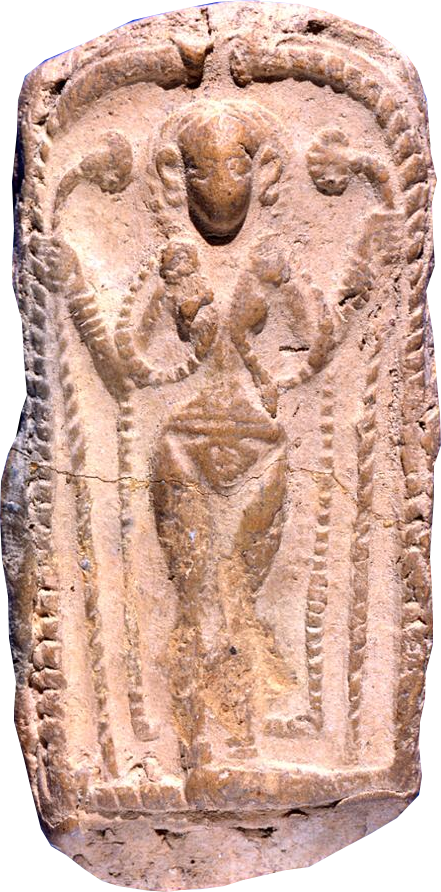Ancient Psychedelia: Alien Gods & Mushroom Goddesses
Online Book - Chapter 1, Page 19
Back to Online Book Mainpage / Next Page (Chapter 1, Page 20)
| Hundreds of nude female terracotta figurines and plaques have been found all over Palestine in excavations throughout the years. The dates of the figurines vary from 2000-1500 BC to 900-600 BC. They consist of all varieties either holding stalks or serpents, or with hands holding breasts, of one hand over the breast and the other hand over the genitals and some are pregnant. All of them undoubtedly represent the goddess. James Pritchard speculates these may have been burial talismans, amulets for attracting the goddess or used for sympathetic magic or idols for stimulating fertility. No male figurines have been found, however, indicating the goddess was far more popular than any god-based religious worship at this time in history. (59) A common goddess object found throughout the area of Tell Beit Mirsim, from the time period of 2000 BC to 1200 BC, are terracotta plaques which have impressions on them of the figure of the goddess Astarte, in a fashion similar to the way cylinder seals were made. Some of these are most impressive as they depict her holding what appear to be mushrooms in her hands (13c). (60) The Astarte figurines recovered from Gezer with their horned head-dress, (61) and a similar representation of the goddess on a stele at Beth-Shan dedicated to Ashtoreth-Karnaim, (62) together with numerous Astarte plaques and fragmentary female figurines in clay and stone from Late Bronze Age and Early Iron Age deposits elsewhere (e.g. Tell Beit Mirsim, Shechem, Megiddo and Gerar) show that the cult was firmly established in Palestine except at Gibeah, Tell en-Nasbeh and Shiloh, and in the early Israelite levels in the central region. (63) The goddess rites survived into the region and time period of biblical Palestine. At Tell en-Nasbeh, temples of Asherah and Yahweh stood next to each other in the 9th century BC, and survived until the city was destroyed. (64) It is likely that Asherah was worshiped here as the consort of Yahweh before the Old Testament was written. When the New Testament compilers left the references to Asherah out of the bible, they created a climate in which the reader would not see the significance or even the role of Asherah and the mother goddess, leaving the reader to imagine that Yahweh was a true “father God” and sole creator. During the Iron Age II (1000 BC on), only so-called “pillar” type figurines have been found in the Jerusalem area. Called Judahite pillar figurines, these are obviously goddess figurines, but they have no legs, only breasts and a head. It has been suggested these are tree trunks. (65) For whatever reason, historians and archaeologists called them “pillars.” (66) Sixteen of these female figurines were found in Jerusalem Cave 1 and Samaria Locus E 207. (67) The Pillar Goddess is just another mushroom goddess. |
 (13c) Astarte c. 1700-1200 BC Farming and Husbandry Domestication of sheep occurred in the Middle East in Mesopotamia around 8000 BC, and cultivation of grains in Palestine and Anatolia during the 8th and 7th millennium BC. Some of the earliest worship centers of culture appeared in Mureybet and Cayonu in the Euphrates Valley as well as Hacilar and Catal Huyuk in Anatolia. (68) The site of Catal Huyuk uncovered in their shrines numerous bull and bull horn artifacts. Bull’s heads with enormous horns or the horns alone, were attached to the walls of these shrines. A Bulls head was left in front of the goddess as well. (69) (59) The Hebrew Goddess, Raphael Patai, Wayne State University Press, 1990 (1967), p.39; Cf. James B. Pritchard, Palestinian Figurines in Relation to Certain Goddesses Known Through Literature. New Haven, 1943, pp. 1, 87 (60) The Hebrew Goddess, p.59-60 (61) Macalister, Gezer, vol. ii, 1912, pp. 419ff (62) A. Rowe, Beth Shan: Topography and History, Philadelphia, 1930, pl. 48 (63) In the Wake of the Goddess: Women, Culture, and the Biblical Transformation of Pagan Myth, Tivka Frymer-Kensky, The Free Press, 1992, p. 159; Melanges Dussaud, i, pp. 118ff.; Albright, Archaeology and the Religion of Israel, p. 114; Macalister, op. cite., vol. iii, pls. ccxx, ccxxi; Petrie, Gerar, 1928, pls. xxxv, xxvi; May, Oriental Institute Communications, vol. xxvi, Chicago, 19--, pls. xxiii-xxxi (64) ibid; W.F. Bade, Quarterly Statement of the Palestine Exploration Fund, lxii, 1930, pp. 12f; Palestine Institute Publications, California, 1928, pp. 30ff., no. 1 (65) ibid; Ruth Hestrin, "The Lachish Ewer and the Asherah," IEJ 37 (1987), 212-213 (66) ibid; See M. Tadmor, "Female Cult Figurines", 171-173; for a catalogue and analysis of those found before 1972, see T.A. Holland "A Study of Palestinian Iron-Age Figurines" (67) ibid., p. 159 (68) Jealous Gods, Chosen People: The Mythology of the Middle East. David Leeming, Oxford University Press, 2004, p. 5 (69) The Goddesses and Gods of Old Europe, p.176 |
Go Back to Page 18